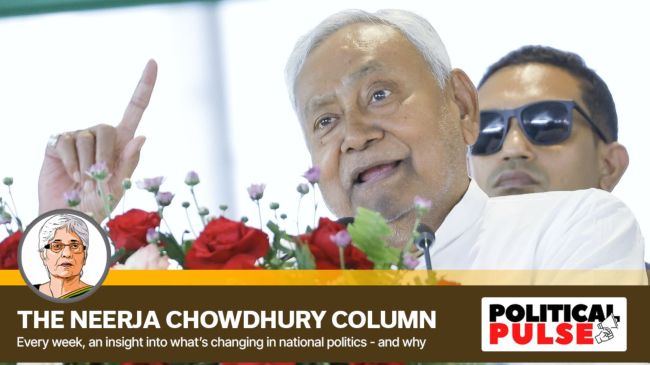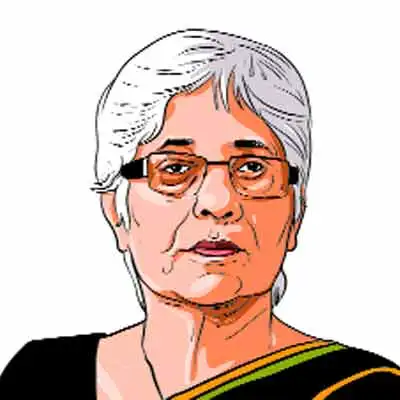There’s a new ‘M’ factor in Bihar elections: Mahila, will it counter Nitish fatigue?
If women voters help Nitish return to power again, schemes like Mukhyamantri Mahila Rozgar Yojana may be seen being rolled out in other poll-bound states too
 Bihar is arguably India’s most politically conscious state, which has set new trends in the past.
Bihar is arguably India’s most politically conscious state, which has set new trends in the past. While things may have cooled down a little on the political front in the country now, Bihar is clearly an exception to this scenario. The Election Commission (EC) has declared a two-phase Assembly elections in Bihar – on November 6 and 11 – with November 14, children’s day, being the D-day when votes will be counted.
That the outcome of the Bihar polls will have a bearing on national politics is to state the obvious. Bihar will set the tenor for the coming Assembly elections in West Bengal, Assam, Tamil Nadu and Kerala in 2026, and more significantly, in Uttar Pradesh, Gujarat and Punjab a year later. Bihar also sends 40 MPs to the Lok Sabha – and numbers are crucial for the ruling BJP, which is short of a majority at the central level.
Equally important, Bihar may indicate the extent to which the BJP has been able to overcome the perceived setback it suffered due to a ceasefire with Pakistan in the wake of the Pahalgam attack and Operation Sindoor.
November 14 will also reveal the impact that the “PK” factor would have on the future trajectory of Bihar politics — relatively less in terms of whose prospects Prashant Kishore, the poll strategist-turned-politician and Jan Suraaj Party (JSP) founder, dents, and more to assess how ready the state is for a post caste-cum-community politics.
Bihar is arguably India’s most politically conscious state, which has set new trends in the past. It was the Jayaprakash Narayan-led Bihar movement which brought about the downfall of the then powerful prime minister Indira Gandhi in 1977 following the Emergency, which led to the rise of the first non-Congress government at the Centre (even though it did not last a full term).
It is Bihar which has been a laboratory for political empowerment of the numerically large but disorganised EBCs (Extremely Backward Classes) – and incumbent Chief Minister and JD(U) president Nitish Kumar has pushed this process. In an evolving democracy, the EBCs have emerged as the “X factor” in recent elections across North India.
To my mind, however, the most fascinating, and far-reaching, revelation of the Bihar polls could be the impact of “MMRY” (Mukhyamantri Mahila Rozgar Yojana) on it.
The larger turnout of female electors than male voters in the last three Bihar Assembly elections since 2010 have established the significance of women as a vote bank. Will the “MMRY” scheme rolled out by Nitish Kumar be a game changer? Could the “M” (Mahila) influence help him counter the fatigue that has set in after 20 years of his rule, corruption allegations surrounding his dispensation, “anti-incumbency” against his MLAs, and above all, his failing health leading to some calling him a “doobta sitara”?
The MMRY scheme is meant to provide Rs 10,000 to one woman in every eligible family as initial support to start an enterprise. Depending on the success of their initiative, additional aid of up to Rs 2 lakh would be given to them. Prime Minister Narendra Modi recently launched this scheme, transferring the first instalment of Rs 10,000 each into the bank accounts of 75 lakh women beneficiaries.
Nitish has obviously seized on the idea of the BJP/NDA governments’ women financial assistance schemes – the Ladli Behen Yojana in Madhya Pradesh and the Ladki Bahin Yojana in Maharashtra – but gone a step further, putting a bigger amount in the hands of women to enable them to start a venture.
These LBY schemes played a vital role in the return of the BJP in Madhya Pradesh in 2023 and that of the Mahayuti in Maharashtra in 2024.
In my conversations with several women from Maharashtra ahead of the November 2024 Assembly polls, I was struck by their response to such schemes. “Our husbands can vote the way they want to, we are going to vote for Eknath Shinde (Shiv Sena chief and then CM). He has put money in our hands,” said some women in a village in Aurangabad district, mostly belonging to the Dalit and OBC groups. They had already started small businesses to augment their families’ income.
Similarly, queuing up outside the Ram Temple in Ayodhya in early 2024, a group of women, who had come from Madhya Pradesh to see the temple, said, “We are all for Narendra Modi”. However, their only complaint was that Modi should have made “Mama” Shivraj Chouhan the Madhya Pradesh CM again following the party’s victory under Chouhan’s chief ministership in the November 2023 Assembly polls. “For it was Mama who had put money in our hands,” they said, referring to the Ladli Behen Yojana.
Women are probably the most aspirational group in the country today – and every political party is pro-actively reaching out to them. “Sushasan Babu” Nitish Kumar was quick to sense this ground level shift in Bihar. Soon after he first came to power in 2005, he had launched a scheme to give cycles and uniforms to girls to encourage them to go to school, which increased their enrolment and decreased their dropout rate. (Those girls are mothers today, influencing choices of their families.)
Later, in 2016, Nitish decided to impose prohibition in the state as a response to women’s complaints about drunkenness and domestic violence in families. The move became controversial because it led to illegal peddling of liquor, men being jailed, and loss of revenue to the state – for which Nitish came under fire. But it won him women’s approval. So did an aggressive policy of reservations for women, including 50% in local bodies, 35% in government jobs – and 35% in the police force.
During my recent travels, especially through rural belts, I asked young women everywhere what they aspired to become, if given half a chance. Their responses were surprising – seven out of 10 said they wanted to be in the police force. Actually, it should not have come as a surprise. For the police force signifies power and freedom, which women seek.
Though other parties in Bihar have also made promises to women in the upcoming polls – RJD leader Tejashwi Yadav has announced a “Mai Bahin Maan Yojana” to give Rs 2,500 per month to each poor and backward woman – Nitish’s credibility with women voters has continued to remain high as compared to his opponents.
The “M” factor seems to be one of the reasons why the BJP decided to let Nitish lead the NDA into the polls despite his health problems. It will be equally difficult to dislodge him if the NDA is victorious as he may again cross over to the Opposition Mahagathbandhan camp to form a government, depending on the numbers thrown up by the polls.
If women voters help Nitish Kumar return to the Pataliputra gaddi once again, schemes like the MMRY, or its variants, may be seen being rolled out in other poll-bound states too. Putting money in the hands of women can only help them and their children get a better life.
(Neerja Chowdhury, Contributing Editor, The Indian Express, has covered the last 11 Lok Sabha elections. She is the author of ‘How Prime Ministers Decide’.)




